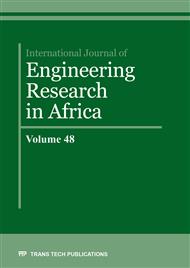[1]
J. Yu, J. Wang, G. Liang, and D. Li, Pure electric vehicle driving system parameter matching in motor higher efficiency interval,, in 2012 International Conference on Systems and Informatics (ICSAI2012), 2012, pp.594-597.
DOI: 10.1109/icsai.2012.6223068
Google Scholar
[2]
M. Zhou, L. Zhao, Y. Zhang, Z. Gao, and R. Pei, Pure electric vehicle power-train parameters matching based on vehicle performance,, vol, vol. 8, pp.53-62, (2015).
DOI: 10.14257/ijca.2015.8.9.06
Google Scholar
[3]
C. D. P. Rodrigues, Design of a High-Speed Transmission for an Electric Vehicle,, (2018).
Google Scholar
[4]
H. N. Hailu and D. T. Redda, Design and Development of Power Transmission System for Green and Light Weight Vehicles: A Review,, The Open Mechanical Engineering Journal, vol. 12, (2018).
DOI: 10.2174/1874155x01812010081
Google Scholar
[5]
K. Holmberg, P. Andersson, and A. Erdemir, Global energy consumption due to friction in passenger cars,, Tribology International, vol. 47, pp.221-234, (2012).
DOI: 10.1016/j.triboint.2011.11.022
Google Scholar
[6]
F. Bottiglione, S. De Pinto, G. Mantriota, and A. Sorniotti, Energy consumption of a battery electric vehicle with infinitely variable transmission,, Energies, vol. 7, pp.8317-8337, (2014).
DOI: 10.3390/en7128317
Google Scholar
[7]
V. Freyermuth, E. Fallas, and A. Rousseau, Comparison of powertrain configuration for plug-in HEVs from a fuel economy perspective,, SAE International Journal of Engines, vol. 1, pp.392-398, (2009).
DOI: 10.4271/2008-01-0461
Google Scholar
[8]
G. Maggetto and J. Van Mierlo, Electric vehicles, hybrid electric vehicles and fuel cell electric vehicles: state of the art and perspectives,, in Annales de Chimie Science des Materiaux, 2001, pp.9-26.
DOI: 10.1016/s0151-9107(01)80066-0
Google Scholar
[9]
D. T. Redda, T. Nakanishi, and G. Deng, Softening behavior of hardness and surface fatigue of rolling-sliding contact in the case of developed alloy steels,, Journal of Advanced Mechanical Design, Systems, and Manufacturing, vol. 3, pp.85-92, (2009).
DOI: 10.1299/jamdsm.3.85
Google Scholar
[10]
I. O. f. Standardization, ISO 6336-1: Calculation of Load Capacity of Spur and Helical Gears. Basic Principles, Introduction and General Influence Factors: ISO, (2007).
DOI: 10.3403/01764632
Google Scholar
[11]
I. Y. Tumer and R. B. Stone, Mapping function to failure mode during component development,, Research in Engineering Design, vol. 14, pp.25-33, (2003).
DOI: 10.1007/s00163-002-0024-y
Google Scholar
[12]
C. Temmel, B. Karlsson, and V. Leicht, Bending fatigue of gear teeth of conventional and isotropic steels,, HTM Journal of Heat Treatment and Materials, vol. 64, pp.80-88, (2009).
DOI: 10.3139/105.110012
Google Scholar
[13]
K. Cavdar, F. Karpat, and F. C. Babalik, Computer aided analysis of bending strength of involute spur gears with asymmetric profile,, Journal of Mechanical Design, vol. 127, pp.477-484, (2005).
DOI: 10.1115/1.1866158
Google Scholar
[14]
P. Fernandes and C. McDuling, Surface contact fatigue failures in gears,, Engineering Failure Analysis, vol. 4, pp.99-107, (1997).
DOI: 10.1016/s1350-6307(97)00006-x
Google Scholar
[15]
H. Bhadeshia, Steels for bearings,, Progress in materials Science, vol. 57, pp.268-435, (2012).
Google Scholar
[16]
D. Girodin, Deep nitrided 32CrMoV13 steel for aerospace bearings applications,, NTN Technical review, vol. 76, pp.24-31, (2008).
Google Scholar
[17]
H. Düzcükoğlu and H. İmrek, A new method for preventing premature pitting formation on spur gears,, Engineering Fracture Mechanics, vol. 75, pp.4431-4438, (2008).
DOI: 10.1016/j.engfracmech.2008.05.004
Google Scholar
[18]
Z. Vigh, Hertzian stress-reducing means for gears,, ed: Google Patents, (1972).
Google Scholar
[19]
S. ANSI, Fundamental Rating Factors and Calculation Methods for Involute Spur and Helical Gear Teeth,, American Gear Manufacturers Association, Alexandria, (2004).
Google Scholar
[20]
D. T. Jelaska, Gears and gear drives: John Wiley & Sons, (2012).
Google Scholar
[21]
H. Naunheimer, B. Bertsche, J. Ryborz, and W. Novak, Automotive transmissions: fundamentals, selection, design and application: Springer Science & Business Media, (2010).
DOI: 10.1007/978-3-642-16214-5
Google Scholar
[22]
H. A. Kishawy and A. Hosseini, Hardened Steels,, in Machining Difficult-to-Cut Materials, ed: Springer, 2019, pp.9-54.
DOI: 10.1007/978-3-319-95966-5_2
Google Scholar
[23]
S. P. Radzevich and D. W. Dudley, Handbook of practical gear design: CRC press, (1994).
Google Scholar
[24]
H. Mohrbacher, Metallurgical concepts for optimized processing and properties of carburizing steel,, Advances in Manufacturing, vol. 4, pp.105-114, (2016).
DOI: 10.1007/s40436-016-0142-9
Google Scholar
[25]
E. Grunditz, Design and assessment of battery electric vehicle powertrain, with respect to performance, energy consumption and electric motor thermal capability: Chalmers University of Technology, (2016).
Google Scholar
[26]
D. Zuev, In China low-speed electric vehicles are driving high-speed urbanization,, The Conversation, (2016).
Google Scholar
[27]
D. Zuev, Urban mobility in modern China: The growth of the e-bike: Springer, (2018).
Google Scholar
[28]
E. Helmers and P. Marx, Electric cars: technical characteristics and environmental impacts,, Environmental Sciences Europe, vol. 24, p.14, (2012).
DOI: 10.1186/2190-4715-24-14
Google Scholar
[29]
N. Raghuraman, S. Jain, and C. Glinsky, Prediction of Dynamic Factors for Helical Gears in a High-Speed Multibody Gearbox System.,.
Google Scholar
[30]
B. Gautham, N. H. Kulkarni, J. H. Panchal, J. K. Allen, and F. Mistree, A method for the preliminary design of gears using a reduced number of American Gear Manufacturers Association (AGMA) correction factors,, Engineering Optimization, vol. 49, pp.565-582, (2017).
DOI: 10.1080/0305215x.2016.1200568
Google Scholar
[31]
S. Beermann, Reliability, Lifetime and Safety Factors.,.
Google Scholar
[32]
M. Rameshkumar, G. Venkatesan, and P. Sivakumar, Finite Element Analysis of High Contact Ratio Gear,, AGMA Technical Paper, 10FTM06, (2010).
Google Scholar
[33]
K. Umezawa, T. Suzuki, H. Houjoh, and T. Sato, Vibration of power transmission helical gears: The effect of contact ratio on the vibration,, Bulletin of JSME, vol. 28, pp.694-700, (1985).
DOI: 10.1299/jsme1958.28.694
Google Scholar


